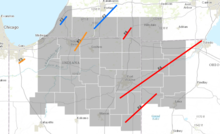This article needs additional citations for verification. (January 2023) |
 Paths of tornadoes over Northern Indiana and Southern Michigan | |
| Tornado outbreak | |
|---|---|
| Maximum rating | F4 tornado |
| Duration | March 28, 1920 |
| Overall effects | |
| Fatalities | ≥ 153 |
| Injuries | ≥ 1,215 |
| Areas affected | Midwestern and Southern United States |
Part of the tornadoes and tornado outbreaks of 1920 | |
On March 28, 1920, a large outbreak of at least 37 tornadoes, 31 of which were significant, took place across the Midwestern and Southern United States. The tornadoes left at least 153 dead and at least 1,215 injured. Many communities and farmers alike were caught off-guard as the storms moved to the northeast at speeds that reached over 60 mph (97 km/h). Most of the fatalities occurred in Georgia (37), Ohio (28), and Indiana (21), while the other states had lesser totals. Little is known about many of the specific tornadoes that occurred, and the list below is only partial. Unusually, the outbreak featured a significant tornado—of F2 or greater status—over Lake Michigan; this was one of only three such occurrences in April or March in more than a century, the other two having taken place on April 3, 1956.[1]
Severe thunderstorms began developing in Missouri during the early morning hours. The storms moved quickly to the northeast towards Chicago, Illinois. The first tornado injured five people 35 mi (56 km) southeast of Springfield, Missouri, in Douglas County. This first tornado was a harbinger of things to come as the morning went on and the atmosphere began to destabilize, due to the abundance of sunshine that preceded the cold front in the warm sector, which covered the lower Great Lakes region extending southward well past the Ohio River Valley.[citation needed][nb 1]
- ^ Ostuno 2008, p. 9.
- ^ Schneider, Russell S.; Brooks, Harold E.; Schaefer, Joseph T. (2004). Tornado Outbreak Day Sequences: Historic Events and Climatology (1875–2003) (PDF). 22nd Conf. Severe Local Storms. Hyannis, Massachusetts: American Meteorological Society. Retrieved September 17, 2019.
Cite error: There are <ref group=nb> tags on this page, but the references will not show without a {{reflist|group=nb}} template (see the help page).